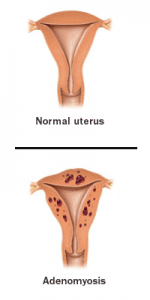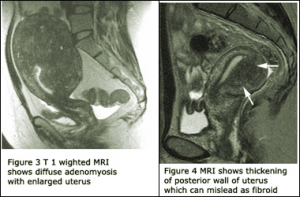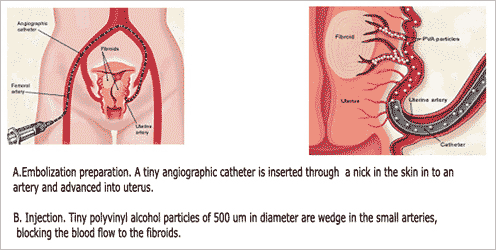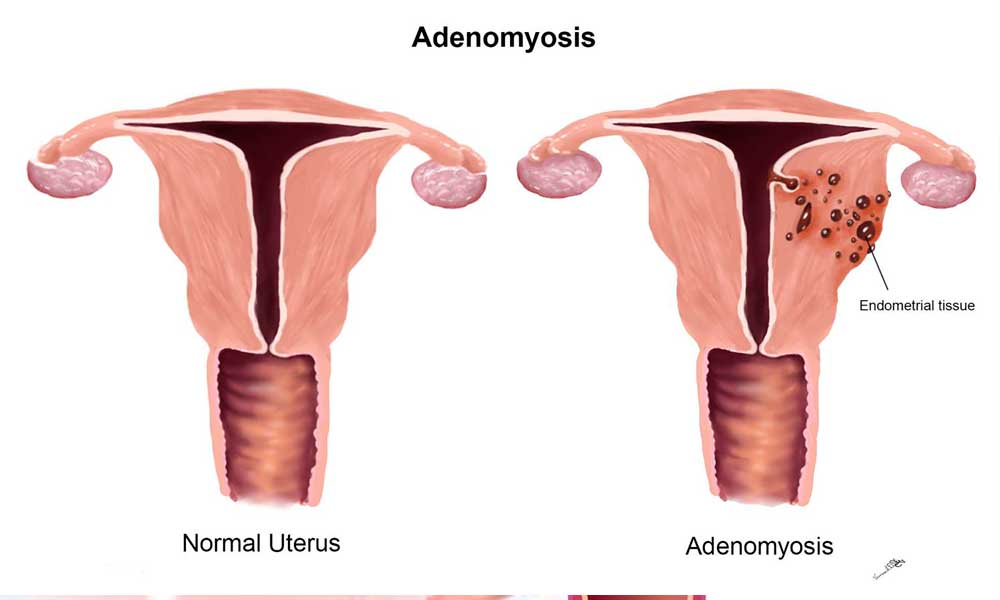What is Adenomyosis?
Adenomyosis is a non cancerous disease of the uterus where symptoms and signs are similar to uterine fibroids. The adenomyosis happens from lining cells of the uterine cavity which grows into the muscle wall of the uterus. During the menstrual cycle, these cells in the muscle bleed as well. And bleeding into the muscle directly causes pain. This blood causes swelling of the muscle which due to irritation become fibrous. This swollen area within the uterine muscle wall is called an adenomyoma, which on sonogram can mimic as fibroid
This condition can involve the entire uterus which becomes bulky and heavy called diffuse adenomyosis or uterine endometriosis. It may be localized in one spot (focal adenomyosis).
Diagnosis of Adenomyosis
Adenomyosis is suspected if the uterus appear bulky (enlarged) and painful to touch during the internal examination.
However, the final diagnosis of adenomyosis is made by scanning using ultrasonography (USG) or magnetic resonance imaging (MRI). The internal ultrasound (TVS) is the most accurate, cheap and widely available. Both scanning techniques shows an enlarged uterus. On ultrasound scan, the uterus will have a heterogeneous and ill-defined pattern.

MRI provides better diagnostic capability due to the increased soft tissue differentiation and able to differentiate adenomyosis from multiple small uterine fibroids. The uterus will have a thickened junctional zone. A thickness of the junctional zone greater than 10 to 12 mm is diagnostic of adenomyosis (<8>
MRI can be used to classify adenomyosis based on the depth of penetration of the ectopic endometrium into the myometrium.
Symptoms of Adenomyosis
Adenomyosis may be mild and may cause no symptoms at all, Though adenomyosis is considered a benign (not life-threatening) condition, it can have a negative impact on a woman’s quality of life. The common symptoms are: –
- Heavy or prolonged menstrual bleeding
- Severe menstrual cramping pain that worsens with age
- Someone with adenomyosis might also feel pain during sexual activities
- Passing of blood clots during period, bleeding between periods or light spotting
- Bladder pressure leading to a constant urge to urinate
- Pressure on bowel, leading to constipation and bloating
- Abnormally enlarged abdomen
- The uterus might also increase in size and feel very tender to touch.
Experiencing any symptoms such as pain or intense bleeding are signs you should get to the doctor immediately to be checked out. The quicker you can get a diagnosis, the quicker you will be able to find appropriate treatment.
Cause of Adenomyosis
- Although the cause of adenomyosis is not known, there are some speculative theories about what might trigger this painful condition
- Some doctors believe procedures such as a cesarean section can promote the invasion of the endometrial cells into the uterine walls
- Adenomyosis lies within the development of the uterus during fetal development. This means that it would originate by the endometrial tissue being deposited into the uterine muscle while you are still a female fetus
- There is also speculation that adenomyosis is caused by uterine inflammation during childbirth. When a woman is postpartum, an inflammation of the uterine lining can occur. This inflammation might break the normal boundaries of the cells within the uterine wall
- One aspect that doctors can agree on, however, is that the growth directly depends upon the production of estrogen. Women who have decreased estrogen production due to menopause will see the adenomyosis go away on its own.
- Since the cause is not exactly known, it is also a little hard to narrow down all of the risk factors associated with the condition. Childbirth and prior uterine surgery are the only two risk factors associated with adenomyosis that are known at this time. Anytime you have surgery on your uterus, you are at a higher risk for developing adenomyosis due to the possible break in the uterine wall
- Cesarean section and removals of fibroids are the two most common uterine surgeries that could cause this condition
Impact on Lifestyle due to Adenomyosis
Adenomyosis is a painful condition but overall is not harmful to your body. Excessive bleeding can have an effect on your daily life and so can the unbearable pain, which might cause you to feel very uncomfortable. You might not find activities as enjoyable as you used to because of the risk of bleeding during the activity. Painful periods are also a problem and can affect your work or school routine, often leaving you calling in sick. The painful periods could also affect your romantic life and make having a relationship difficult. The pain could lead to anxiety, depression, irritability, and feelings of helplessness. You should always seek medical attention if you feel any symptoms related to adenomyosis so that you can find appropriate treatment options to help you cope with the condition.
Treatment options of Adenomyosis (uterine endometriosis)
- Medical Treatment: Adenomyosis has been a frustrating disease to treat; medical treatment with oral progesterone or birth control pills often does not work. According to a recent study, the progesterone-containing IUD (Adenomyosis) can help with menstrual cramping for short time in about 40 to 50% of women. The common side effects from this IUD are weight gain (29%), benign ovarian cysts (22%) and lower abdominal pain (12%).
- Surgical Treatment: Hysterectomy (surgical removal of the uterus) Till now removal of the uterus was the only available option for treatment of adenomyosis. But Now no need to remove the uterus.
- Non Surgical Treatment (Uterine Artery Embolization): This is the latest & the best treatment available now allowing reservation of uterus.
Non-surgical Treatment for Adenomyosis- Uterine Artery Embolization
It is a minimally invasive interventional radiological procedure, which means it requires only a tiny nick in the skin. It is performed under sedation or mild local anesthesia – feeling no pain and usually requires a hospital stay of one night. Many women resume light activities in a few days and the majority of women are able to return to normal activities within a week.
Benefit of Uterine Artery Embolization
- It treats both focal or diffuse adenomyosis.
- It treats adenomyosis associated with single/multiple fibroids
- UAE treats focal and diffuse adenomyosis and all uterine fibroids at the same time and is, therefore, an extremely effective.
Procedure: The interventional Radiologist makes a small nick in the skin (less the ¼ of an inch) at groin, inserts a catheter, identifies uterine artery by using angiography with contrast media injection and then inject embolization particles (polyvinyl alcohol) that block the tiny vessels supplying adenomyosis and all the fibroids. This blockage of blood supply to abnormal endometriosis tissue and fibroids causes infarction) and subsequent degeneration of the adenomyosis and it starts reduction in size of uterus in a few weeks. Symptoms like bleeding and pain resolve in 85% to 95% of patients.
Uterine artery embolization has many Indications:-
- Focal or diffuse adenomyosis.
- Single / multiple Uterine Fibroids.
- Failed myomectomy/recurrence of fibroids after myomectomy
- High-risk patient for surgery like obesity, anemia, chronic renal failure etc.
- Postpartum Hemorrhage
- Bleeding from Cancer of Cervix & Uterus
- Pre-operative embolization to reduce bleeding during uterine surgery.
Advantages of Uterine artery embolization
- It is performed under mild sedation feeling no pain.
- Requires only a tiny nick in the skin (No surgical incision of abdomen).
- Recovery is shorter than from hysterectomy or open surgery
- Virtually no adhesion or scar formation has been found. But in surgery adhesions are common.
- Adenomyosis and if fibroids are present in uterus are treated at together in one sitting, which is not the case with surgery.
- The overall successes rate is about 95%.
- Uterine artery embolization involves virtually no blood loss or risk of blood transfusion.
- If the presenting complaint was severe pain & excess vaginal bleeding, 90-95% of cases experiences resolution within 24 hours.
- Emotionally, financially and physically – embolization can have an overall advantage over other procedures for the patient as the uterus is not removed.
